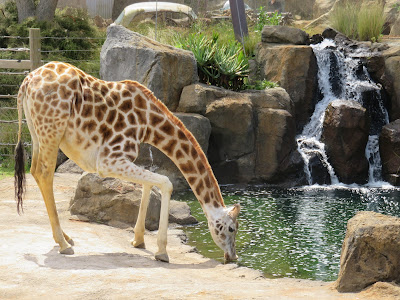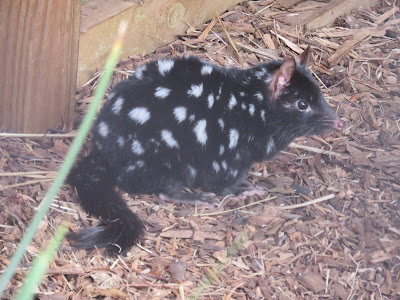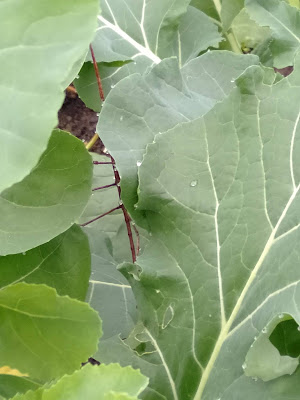My article Immersed in the Gorge was published in the September 2019 issue
of the US online magazine 'Write Launch'.
I often visit a special place not
far from my home. Here I am revived; here I can observe and here my soul feeds on
nature in all its forms. I feel privileged to be able to call this place my own:
Cataract Gorge in Launceston, Tasmania.
We owe the discovery of this unique
site to explorer William Collins who, in 1804, ‘…observed a large fall of
water over rocks, near a quarter of a mile up a strait gully, between
perpendicular rocks, about one hundred and fifty feet high; the beauty of the Scene is probably not
surpass'd in the world; this great waterfall or cataract is most likely one of
the greatest sources of this beautiful river, every part of which abounds with swans,
ducks, and other kinds of wildfowl.
At the time Collins was searching
for a source of fresh, clean water for the early settlers to use; the gorge then
became a vital link in the growth of the new settlement. Prior to this it is
thought the aboriginal community was present in the gorge, using the water and
perhaps food and shelter, but there remains little archaeological evidence. Some
aborigines believe evil spirits occupied the gorge in order to protect their
people and future generations, and aboriginal women in particular have felt
uncomfortable upon entering the area, believing it may have once been a sacred
site for their men.
The history of the gorge dates back
hundreds of millions of years, to its volcanic and explosive creation. Deep beneath
the first basin is a concentration of fault lines that coalesced millions of
years ago to form not one, but three devastating earthquakes, giving rise to
its creation. Local geologist Peter Manchester says, ‘You can actually see
the cross-section of the movements of the faults on the sides, up near where
the suspension bridge is, down the centre of the Gorge.’ These movements
and fault lines have not been weathered away, he says, which explains how the
current landscape formed.
Down the gorge, the South Esk River
winds its way past Jurassic dolerite cliffs to the Tamar Estuary. And the cataract
section was probably created some 10,000 years ago, also following a massive
earthquake.
So why am I drawn to the Gorge? I
am intrigued by its violent past; and the contrast of its serene waters and
sheer rocky cliffs is dramatic and breathtakingly beautiful. I also feel a
respect for those who walked before me; whose lives were not easy at settlement
nor during the eons before. But the Gorge is a mecca for native birds and
animals and the chance of seeing its unique inhabitants again brings me here,
time and again.
As I wander down through the
southern entrance of this 192-hectare site I spy a superb fairy wren on the
branch of a shrub. I stop to watch him. His brilliant blue feathers match the
cloudless sky with perfection, and he appears unperturbed by my presence as he
goes about his daily preening.
I reach the ford at the first
basin, where water gathers in slowly before rushing beneath my feet to create a
second waterfall on the downhill side. It is here that water birds abound and ducks
and ducklings, swans and cygnets are frequent visitors. And I am told that hidden
beneath the waters of the basin is an aquatic wonderland of blackfish, long-finned
eel, redfin perch and brown trout, to name but a few.
Occasionally an adventurous Australian
fur seal makes its way up the Tamar Estuary to sun itself on the cliff face
above the Gorge. There it will stay for days at a time, feasting on eel. Today,
however, only one lone cormorant perches on a rocky outcrop in the basin,
his wings spread full, taking in the sun.
I take the path to the cliff grounds.
In 1904 the local mayor noted that, ‘strangers who visit them for the first
time are lost in wonder and admiration of the beautiful scenery.’ The same
can surely be said even still. I go right and climb even further up through a
forest of tree ferns that slope down sharply to the river, hundreds of metres
below.
At the top two giant sequoias,
Californian Redwoods, guard the entrance to a beautiful dell. One of these
trees was planted in memory of prominent early residents William and Isabella
Barnes who, in the late 1800s gave this land to the city for the people of
Launceston to enjoy.
The dell is a place of shelter and
refuge for humans and wildlife, enclosed by oaks and London plane trees, along
with gardens of blue, pink, purple and white hydrangeas, and azaleas and
rhododendrons that bloom brilliantly in spring. An enormous native olive tree fans
its branches out towards the centre of the dell and beyond, amid a copse of
bright green tree ferns sits the ancient rotunda, the site of evening
entertainments in Victorian times.
To my right a rock wall is submerged
in dark green ivy which trails down to meet the grassy floor, partly laid in a carpet
of bright green moss. I take a seat on a bench under the canopy of a large
birch tree.
Today I am thrilled to see a pademelon
nearby, busily foraging. I remain still, hopeful he will stay a while. The
Tasmanian pademelon, also called the rufous or red-bellied pademelon, is just
one of many mammals to be found within the Gorge, in addition to snails,
spiders, frogs, lizards, skinks and even snakes. At other times I have seen
wallaby and an occasional echidna, but never the shy nocturnal bandicoot that
inhabits these grounds.
Recently I was introduced to the
Japanese art of shinrin yoku – or forest bathing. The Japanese believe the benefits
of simply walking through a wild or natural area in a relaxed way can induce
feelings of calm rejuvenation and increase our flow of energy. Now I relax onto
the bench, take a few deep breaths and listen.
To my right I hear the loud ‘whip’
of a Golden Whistler and I follow its flight to the lower branches of the olive
tree. On the ground, a common blackbird pecks amongst leaf litter on the floor
of the dell, discovers what must surely be a worm and flies off to its nest. I
close my eyes and then, in the distance, hear the coo-coo of a dove.
A breeze sighs through the
shrubbery and brushes my arms. I take another deep breath and as the scent of the
forest envelopes me, I find myself at peace. But my contemplation is broken by a
screech. Startled, I look up to see a peacock nestled in the branches of a
magnolia tree. Peacocks are the most striking of the gorge birds with their iridescent
blue-green feathers and long graceful tails. They were introduced early in the
twentieth century as an exotic feature and now, sadly, less than a dozen remain;
all males.
A rustling in the bushes reveals a curious
peacock who makes his way slowly towards me. He stops a metre or so away and
cocks his head, his eyes trained on me. I say hello and he moves closer,
pecking at the moss on the ground before me. He seems completely unafraid. At
last he wanders away and I see that the pademelon too has left me, so once
again I close my eyes.
Now I am aware of the crash of
cascading water down at the ford, and imagine it rushing down over the rocks
that break the surface at the top of the South Esk River. There it begins its
kilometre journey to meet the Tamar Estuary, between those impressive dolerite cliffs.
Eventually, muted voices tell me I
am no longer alone. I open my eyes and watch the shadows of overhanging
branches dance across the mossy carpet. Then, stretching, I rise and wander over
to the olive tree. There, on a leaf, a pair of Harlequin Bugs is joined
together in a strange mating dance, their brilliant red and black shells spectacular
against the rich green of the leaves.
Following the rocky path from the
dell with the river to my right, I cross a narrow bridge to reach a wire-fenced
viewing platform overlooking the tranquil gorge. Once, further upstream, a
fourth basin existed but decades ago it was dammed to become the Trevallyn
Lake. Now, in heavy sustained rains, water released from the dam barrels down
the gorge. I can still visualise the rapids from last winter as flurries of
white foam spiralled up the cliff faces on both sides whilst masses of
spectators looked on, cameras at the ready.
Now the vegetation has changed and
here, sparse windswept scrub and trees with exposed roots hang from rocks metres
above me. What a contrast to the lushness of the dell. I step around Dog Rock, one
of the gorge’s natural rock features and pass a set of hewn stone steps heading
up, and a series of shallow caves. I wonder who created them – was it the first
settlers or the elusive indigenous peoples. Naturalist John Muir said, ‘In
every walk with nature one receives far more than he seeks,’ and I can’t
help but think there is so much to this place that I have yet to discover.
Towards the end of the path the majestic
Kings Bridge Cottage is perched high above me in the cliff. Built in the 1890s
it was home to the gorge’s original gatekeeper. Now there is no gate to keep and
the cottage is home to an Artist in Residence program.
From the earliest days of discovery
artists and photographers have rendered the gorge in a variety of media. Even
in black and white the beauty of the gorge is evident in the proliferation of
photographs that date from the 1860s. The cliff grounds, By 1904, were the most
popular place to visit in Launceston. Following the introduction of colour
photography in 1907, so many photographs were taken here that in 1912 the Town
Clerk was forced to decree, ‘…the Council does not permit photographers to
canvass for business or sell photographs in the Cliff Grounds.’
In art too, the gorge is
immortalised. John Glover, arguably Australia’s most celebrated colonial landscape
artist, produced numerous sketches and paintings of the gorge including Tasmanian
Gorge, and The Cataract on the South
Esk River near Launceston, Van Diemen’s Land. But it is Gladstone Eyre’s watercolour
The First Basin that captivates me
the most. This atmospheric painting hangs in its heavy gilt frame in the Queen
Victoria Art Gallery in Launceston.
In it, a woman sits alone in a
rowboat just metres from the rocky shore. The water is dark and in parts rippled,
the rowboat reflected in its mirrored surface. From beneath the tree-topped
hills beyond, ancient dolerite boulders jut out at odd angles as if having suddenly
risen from the basin.
This painting embodies all that I
love about this place. Each time I come to the gorge I make new discoveries; changing
foliage, other wildlife, unique sounds and smells. And I leave with visions and
memories, and the desire to return.
As Marcel Proust said, ‘The real
voyage of discovery consists not in seeking new landscapes, but of having new
eyes.’





















































